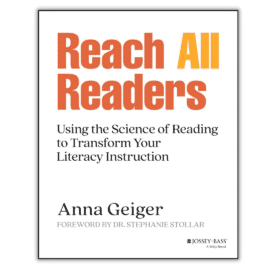
TRT Podcast #102: How to make the most of repeated reading
The research is clear: repeated reading builds fluency! In today’s quick episode we’ll explore best practices for repeated reading … so you can make the most of it.
Listen to the episode here
Full episode transcript
Hello, Anna here with Episode 102 of the Triple R Teaching Podcast. Today we're going to conclude our fluency series by talking about repeated reading.
I'm always surprised when I'm in a big Facebook group about the science of reading and someone implies that repeated reading really doesn't improve fluency. That's simply not true because research has shown us many times that repeated reading DOES improve reading fluency. But there are some things we need to think about when we think about repeated reading.
So repeated reading, of course, is reading the same text multiple times until a certain or better level of fluency is reached. We've known since the 1970s that repeated reading improves fluency. In 1979, Jay Samuels, who's one of the big names when it comes to fluency research, asked students with learning difficulties to read a short passage orally several times. With each reading, the students had greater accuracy, speed, and comprehension. But here's the best part, as they were given other passages of equal or greater difficulty, their first readings of those passages were better than their first reading of the initial passage. In other words, the gains from repeatedly reading one text transferred to other texts.
Here are some benefits of repeated reading that Tim Rasinski shares in his book, "The Fluent Reader." Repeated reading improves comprehension, and this improvement in comprehension extends to unpracticed passages as well. Repeated reading leads to greater word recognition accuracy. Repeated reading usually leads to better reading performance. And when students are given real reasons for repeated reading, like to read a play or a poem in front of a group, they're often more than willing to practice.
Here are some tips for doing repeated reading with the whole class: You could choose a text of an appropriate length, 50 to 200 words, depending on student ability.
Make sure you choose the appropriate level of text. Now, to be honest, experts disagree on this. Tim Shanahan suggests texts at students' frustration levels, otherwise, there won't be much improvement with successive readings. Others think the text should be closer to students' independent levels. If you choose a frustration level text, you must be there to give appropriate support.
Finally, if students are not doing repeated reading for a performance, then up to four reads is enough for a single text. Research has not shown fluency gains after that number of readings.
I also want to let you know that it's really important that there's feedback given to students on their reading. So whether that's feedback from another student, or a parent, or from you, the teacher, that's really useful. Having someone just sit and read something over and over may not be useful, particularly if they're a struggling reader, because they may be repeating their mistakes. So make sure there's feedback to help them make corrections as needed.
When it comes to types of repeated reading, one thing students could do at centers is to read along with an audio recording of a text until they can read it independently. Note that I said read along, not just listen. Simply listening is not going to improve reading fluency.
There's also a partner reading where students can read a partner play multiple times.
Something else you could do is a Fluency Development Lesson. I have a blog post all about that which I'll link to in the show notes. I recommend doing that with a poem because that's a fun thing to read and you can do a new poem every day.
And finally, you could do Reader's Theater where students take turns reading parts of a script and perform it at the end of the week. If you missed Episode 101 from last week, you can find out how Dr. Chase Young recommends implementing Reader's Theater day to day in your classroom.
I have many resources in my shop that support fluency, and you can find them by going to themeasuredmom.com/shop and then just select "Fluency" in the sidebar and all of those resources will come up. You should also check out the show notes for links to articles that I referenced when creating this episode. You can find the show notes at themeasuredmom.com/episode102. Talk to you next time!
Sign up to receive email updates
Enter your name and email address below and I'll send you periodic updates about the podcast.
Fluency resources from my shop
References
Rasinski, T. (2010). The fluent reader. Scholastic. Shanahan, T. (2017, August 4). Everything you wanted to know about repeated reading. Reading Rockets. https://www.readingrockets.org/blogs/shanahan-literacy/everything-you-wanted-know-about-repeated-reading
Pre-order my new book and get a FREE bonus!

You’ll love this reader-friendly guide to the science of reading! Learn how to put the research into action so you can reach ALL readers. Pre-order before July 23 and get my Science of Reading Mini-Course – FREE!
The post How to make the most of repeated reading appeared first on The Measured Mom.



















